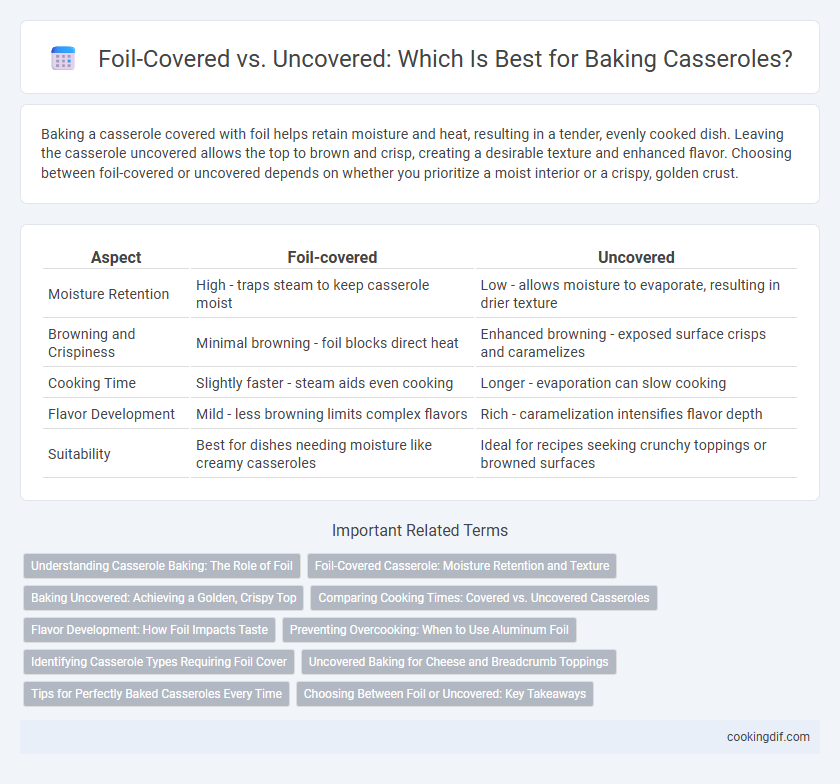Baking a casserole covered with foil helps retain moisture and heat, resulting in a tender, evenly cooked dish. Leaving the casserole uncovered allows the top to brown and crisp, creating a desirable texture and enhanced flavor. Choosing between foil-covered or uncovered depends on whether you prioritize a moist interior or a crispy, golden crust.
Table of Comparison
| Aspect | Foil-covered | Uncovered |
|---|---|---|
| Moisture Retention | High - traps steam to keep casserole moist | Low - allows moisture to evaporate, resulting in drier texture |
| Browning and Crispiness | Minimal browning - foil blocks direct heat | Enhanced browning - exposed surface crisps and caramelizes |
| Cooking Time | Slightly faster - steam aids even cooking | Longer - evaporation can slow cooking |
| Flavor Development | Mild - less browning limits complex flavors | Rich - caramelization intensifies flavor depth |
| Suitability | Best for dishes needing moisture like creamy casseroles | Ideal for recipes seeking crunchy toppings or browned surfaces |
Understanding Casserole Baking: The Role of Foil
Foil-covered casseroles retain moisture by trapping steam, resulting in tender, evenly cooked dishes with a moist texture. Uncovered baking allows the top to brown and crisp, enhancing flavor through Maillard reactions and creating a more textured surface. Choosing foil coverage depends on whether moisture retention or a crispy crust is desired for the finished casserole.
Foil-Covered Casserole: Moisture Retention and Texture
Foil-covered casseroles trap steam during baking, preserving moisture and ensuring a tender, succulent texture throughout the dish. This method prevents the casserole from drying out, which is particularly beneficial for recipes containing delicate ingredients like vegetables, poultry, or creamy sauces. Using foil also promotes even cooking by distributing heat more consistently across the casserole's surface.
Baking Uncovered: Achieving a Golden, Crispy Top
Baking a casserole uncovered allows moisture to evaporate, resulting in a golden, crispy top that enhances texture and flavor. This technique is ideal for dishes like macaroni and cheese or vegetable casseroles, where a crunchy surface adds contrast to a creamy interior. Maintaining optimal oven temperature ensures even browning without drying out the casserole.
Comparing Cooking Times: Covered vs. Uncovered Casseroles
Foil-covered casseroles retain moisture and heat, reducing cooking times by up to 20% compared to uncovered dishes. Uncovered casseroles develop a crispy, browned topping but require longer baking, often adding 10-15 minutes. Choosing foil coverage depends on desired texture and moisture retention during the cooking process.
Flavor Development: How Foil Impacts Taste
Foil-covered casseroles retain moisture and prevent the surface from browning, resulting in a softer texture but less pronounced caramelization and flavor depth. Uncovered casseroles allow for evaporation, promoting Maillard reactions that enhance browning and develop richer, more complex flavors. Balancing coverage during baking can optimize both moisture retention and flavor intensity for a well-rounded casserole.
Preventing Overcooking: When to Use Aluminum Foil
Using aluminum foil to cover casseroles during baking helps retain moisture and prevents overcooking, especially for dishes with ingredients prone to drying out like chicken, pasta, or rice. Foil should be used during the initial baking phase to protect the surface and maintain internal temperature, then removed near the end to allow browning and crisping. Uncovered casseroles promote a crispy top but increase the risk of drying out if baked too long or at high heat.
Identifying Casserole Types Requiring Foil Cover
Casseroles containing ingredients prone to drying out or requiring moist heat, such as rice-based or cheesy dishes, benefit from foil cover to retain moisture and ensure even cooking. Foil-covered casseroles like lasagna, gratins, and baked pasta prevent top layer over-browning while allowing internal steam circulation. Conversely, casseroles with crispy toppings, such as breadcrumb or nut crusts, require baking uncovered to achieve desired texture and browning.
Uncovered Baking for Cheese and Breadcrumb Toppings
Uncovered baking is ideal for casseroles with cheese and breadcrumb toppings, allowing them to brown and crisp evenly under direct heat. This method promotes caramelization and enhances texture, creating a golden, crunchy crust that foil-covered casseroles cannot achieve. Baking uncovered ensures moisture evaporates sufficiently, preventing soggy toppings and preserving a desirable contrast with the creamy interior.
Tips for Perfectly Baked Casseroles Every Time
Covering casseroles with foil during baking traps moisture, preventing the dish from drying out and ensuring even heat distribution for tender results. Removing the foil in the last 10-15 minutes allows the top to brown and crisp, adding appealing texture and flavor. For dense casseroles, partially covering with foil can balance moisture retention and browning, producing perfectly baked dishes every time.
Choosing Between Foil or Uncovered: Key Takeaways
Choosing between foil-covered and uncovered casserole baking depends on desired texture and moisture levels. Foil-covered casseroles retain moisture, resulting in a tender, juicy interior, ideal for dishes like lasagna or green bean casserole. Uncovered baking promotes browning and crispiness on top, perfect for gratins or dishes that benefit from a crunchy crust.
Foil-covered vs Uncovered for casserole baking Infographic

 cookingdif.com
cookingdif.com